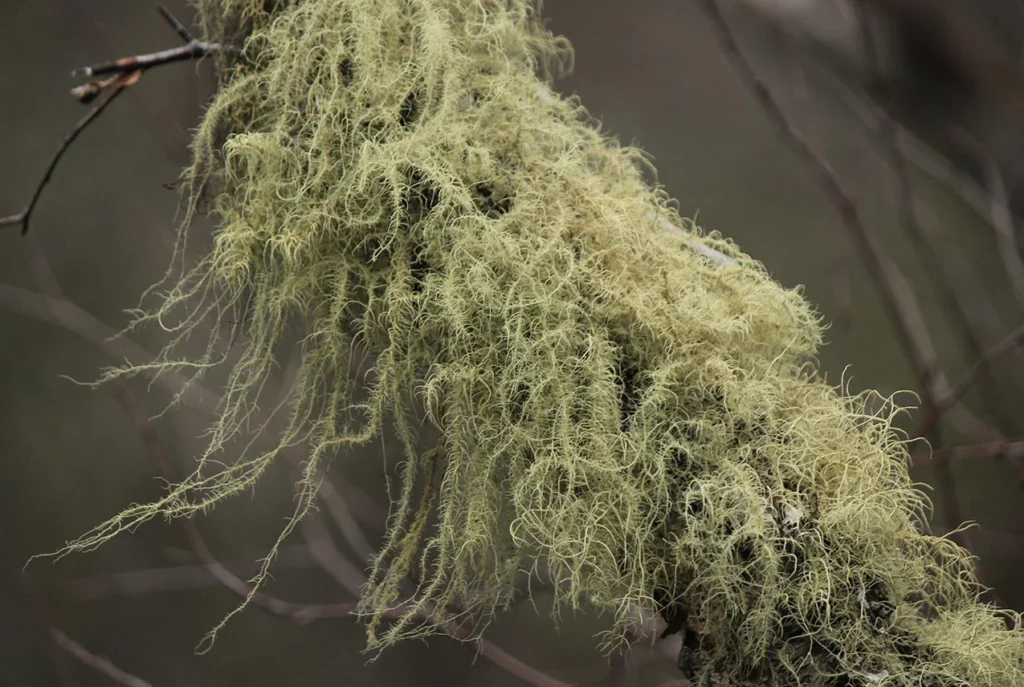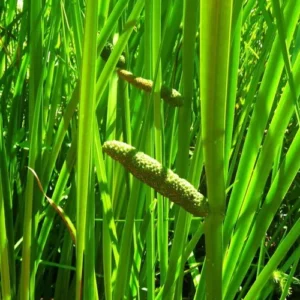Usnea

Usnea, commonly known as Old Man’s Beard or Beard Lichen, is a type of lichen that grows on trees, appearing as wispy, pale green, or gray strands. It is widely recognized for its medicinal properties and has been used in traditional medicine for centuries. Usnea thrives in humid, temperate forests and is often found hanging from the branches of trees, particularly conifers.
1. Size:
- Usnea varies in length, typically growing from a few inches to over a foot long. The strands can be fine and thread-like or thicker and bushier, depending on the specific species and growing conditions.
2. Color:
- Usnea is generally pale green to grayish-green, with the inner core being white. The outer layer of the lichen is where the greenish hue is most prominent, attributed to the presence of algae.
3. Texture:
- The texture of Usnea is soft and pliable when fresh, becoming brittle and more fragile when dry. The strands are composed of a central, white core wrapped in a softer, outer layer.
4. Fragrance:
- Usnea has a subtle, earthy scent that is not particularly strong but can be noticed when handling or crushing the lichen.
5. Uses:
- Usnea is renowned for its antimicrobial and antifungal properties, making it a valuable herb in traditional medicine. It is often used to treat respiratory infections, wounds, and skin conditions.
- In some cultures, Usnea has been used as a natural dye, imparting a yellow or greenish hue to fabrics and textiles.
- Usnea can be used as a fire starter in survival situations due to its fibrous nature. It has also been used historically as a makeshift bandage for wounds.
6. Habitat:
- Usnea grows in moist, temperate forests and is often found in areas with clean air, as it is sensitive to pollution. It typically hangs from the branches of trees, particularly in coniferous forests, but can also be found on deciduous trees and rocks in some regions.
7. Cultural and Spiritual Significance:
- In various cultures, Usnea is associated with longevity and resilience due to its slow growth and ability to survive in harsh environments. It is sometimes used in rituals to promote health and longevity.
- Usnea has been used in traditional healing practices to ward off evil spirits and promote spiritual protection. It is also believed to connect the physical and spiritual realms, making it a popular choice in spiritual baths and rituals.
Spiritual Properties
- Protection and Purification: Usnea is often used in spiritual practices for protection and purification. It is believed to ward off negative energies and cleanse spaces or individuals from harmful influences. Usnea can be burned as incense or carried as a talisman for these purposes.
- Connection to Nature: Due to its close association with trees and its presence in untouched, pristine environments, Usnea is seen as a symbol of nature’s wisdom and strength. It is used in rituals to enhance one’s connection with the natural world and to draw upon the earth’s energies.
- Enhancing Intuition: Usnea is believed to aid in the development of intuition and spiritual insight. It is used in meditation and other spiritual practices to open the mind and enhance the ability to perceive subtle energies.
Medicinal Properties
- Antimicrobial: Usnea contains usnic acid, a compound known for its strong antimicrobial properties. It has been used to treat bacterial and fungal infections, particularly those affecting the respiratory and urinary tracts.
- Anti-inflammatory: The anti-inflammatory properties of Usnea make it effective in treating conditions such as arthritis, bronchitis, and skin irritations. It helps reduce inflammation and promote healing in affected areas.
- Wound Healing: Usnea has been traditionally applied to wounds as a natural antiseptic and bandage. Its ability to prevent infection and promote healing makes it a valuable resource in herbal medicine.
- Respiratory Health: Usnea is often used to treat respiratory issues such as coughs, colds, and sore throats. It is believed to soothe the mucous membranes and reduce inflammation in the respiratory tract.
Allergic Reactions
Usnea is generally considered safe for external use and consumption in small amounts. However, some individuals may experience allergic reactions or side effects.
- Skin Irritation: Prolonged contact with Usnea may cause skin irritation or dermatitis, especially in individuals with sensitive skin. Symptoms could include redness, itching, or a rash.
- Respiratory Sensitivity: Inhaling dust from dried Usnea or using it in a concentrated form may cause respiratory irritation in sensitive individuals, particularly those with asthma.
- Gastrointestinal Discomfort: Ingesting large amounts of Usnea may lead to gastrointestinal discomfort, including nausea, vomiting, or stomach cramps. It is recommended to use Usnea sparingly and under the guidance of a healthcare professional.
- Liver Toxicity: Some studies suggest that high doses of usnic acid, found in Usnea, could potentially cause liver toxicity. It is advisable to use Usnea with caution, particularly in supplement form.
- Digestive Issues: Consuming Usnea in large quantities may cause digestive upset, including nausea and stomach cramps. It is advised to use it sparingly in teas or tinctures.
- Potential Hormonal Effects: Usnea may have mild hormonal effects, and its use should be approached cautiously, especially by those with hormone-sensitive conditions or women who are pregnant or breastfeeding.

Uva Ursi
Uva Ursi Uva Ursi, also known as bearberry, is a small, evergreen shrub that is prized for its medicinal properties, particularly in treating urinary tract

Lemon Balm & Honey Healing Cookies
Lemon Balm and Honey Healing Cookies These light and flavorful cookies offer a perfect way to relax and soothe the spirit while enjoying a delicious

Himalayan Pink Salt
Himalayan Pink Salt Himalayan pink salt is renowned for its distinct and attractive appearance. Typically found in large crystals or fine granules, it displays a

Rosemary for Cognitive Health: A Natural Boost?
Rosemary for Cognitive Health: A Natural Boost? Rosemary has long been cherished for its medicinal properties, especially for its potential cognitive-enhancing abilities. Traditionally, rosemary has

Calamus Root
Calamus Root Calamus Root, derived from the rhizome of Acorus calamus, is a well-known herb in traditional medicine and spiritual practices. Known for its aromatic

Marshmallow Leaf & Root
Marshmallow Leaf & Root Marshmallow Leaf and Root come from the Marshmallow plant (Althaea officinalis), a perennial herb known for its soothing properties. Both the